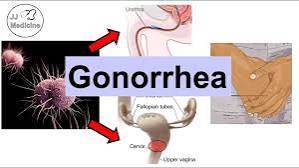Gonorrhea
Gonorrhea is a sexually transmitted infection (STI) caused by the bacterium Neisseria gonorrhoeae. It affects the mucous membranes of the reproductive tract, rectum, throat, and eyes. Untreated gonorrhea can lead to serious health complications.
---
Causes
1. Sexual Transmission:
Unprotected vaginal, anal, or oral sex with an infected partner.
2. Vertical Transmission:
From an infected mother to her baby during childbirth.
Risk factors include:
Having multiple sexual partners.
Not using condoms or other protective methods.
History of other STIs.
Sexual activity with an infected partner.
---
Signs and Symptoms
In Men:
Burning sensation during urination.
White, yellow, or green penile discharge.
Swollen or painful testicles (rare).
In Women:
Increased vaginal discharge.
Painful urination.
Intermenstrual bleeding.
Pelvic or abdominal pain (indicates possible pelvic inflammatory disease).
In Both Genders:
Rectal Infection: Pain, discharge, itching, or bleeding from the anus.
Throat Infection: Sore throat, though often asymptomatic.
Eye Infection: Redness, pain, and discharge if bacteria infect the eyes.
---
Effects
1. Untreated Gonorrhea:
In Men: Epididymitis, which can lead to infertility.
In Women: Pelvic inflammatory disease (PID), causing chronic pelvic pain, ectopic pregnancy, or infertility.
2. Disseminated Gonococcal Infection (DGI):
Spread of the bacteria to the bloodstream, leading to fever, joint pain, and skin lesions.
3. Increased HIV Risk:
Gonorrhea increases susceptibility to HIV infection.
4. Neonatal Complications:
Infected babies can develop severe eye infections (ophthalmia neonatorum), potentially leading to blindness.
---
Solutions
1. Diagnosis:
Laboratory Tests:
Nucleic acid amplification tests (NAATs) using urine, swab samples from the affected area (cervix, urethra, rectum, or throat).
Gram Stain: Useful for immediate diagnosis in symptomatic men.
2. Treatment:
Antibiotics:
The standard treatment is a single dose of ceftriaxone (injection).
If coinfected with chlamydia, azithromycin or doxycycline may be added.
Partner Notification and Treatment:
Treating sexual partners to prevent reinfection.
3. Supportive Care:
Pain Management: Over-the-counter pain relievers for discomfort.
Hydration and Rest: For general well-being.
4. Prevention:
Use Condoms: Correct and consistent use during sexual activity.
Regular STI Testing: Especially for sexually active individuals with multiple partners.
Limit Sexual Partners: Reducing the number of partners lowers risk.
Education and Awareness: Understanding STI transmission and symptoms.
Avoid Sharing Sex Toys: If sharing, use condoms on the toys and clean them properly.
5. Pregnancy Management:
Pregnant women should be screened and treated to prevent neonatal complications.
---
Prognosis
With prompt and appropriate antibiotic treatment, gonorrhea can be cured, and complications can be avoided. However, antibiotic resistance is a growing concern, making early detection and treatment critical. Regular check-ups and preventive measures are key to managing and reducing the spread of gonorrhea.


